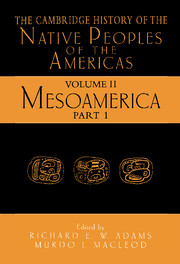Book contents
- Frontmatter
- Contents
- List of Illustrations
- Part I
- 1 Introduction to a Survey of the Native Prehistoric Cultures of Mesoamerica
- 2 The Paleoindian and Archaic Cultures of Mesoamerica
- 3 The Preclassic Societies of the Central Highlands of Mesoamerica
- 4 The Precolumbian Cultures of the Gulf Coast
- 5 The Maya Lowlands: Pioneer Farmers to Merchant Princes
- 6 The Central Mexican Highlands from the Rise of Teotihuacan to the Decline of Tula
- 7 Western and Northwestern Mexico
- 8 Cultural Evolution in Oaxaca: The Origins of the Zapotec and Mixtec Civilizations
- 9 The Southeast Frontiers of Mesoamerica
- 10 The Maya Highlands and the Adjacent Pacific Coast
- 11 The Aztecs and Their Contemporaries: The Central and Eastern Mexican Highlands
- Index
2 - The Paleoindian and Archaic Cultures of Mesoamerica
Published online by Cambridge University Press: 28 March 2008
- Frontmatter
- Contents
- List of Illustrations
- Part I
- 1 Introduction to a Survey of the Native Prehistoric Cultures of Mesoamerica
- 2 The Paleoindian and Archaic Cultures of Mesoamerica
- 3 The Preclassic Societies of the Central Highlands of Mesoamerica
- 4 The Precolumbian Cultures of the Gulf Coast
- 5 The Maya Lowlands: Pioneer Farmers to Merchant Princes
- 6 The Central Mexican Highlands from the Rise of Teotihuacan to the Decline of Tula
- 7 Western and Northwestern Mexico
- 8 Cultural Evolution in Oaxaca: The Origins of the Zapotec and Mixtec Civilizations
- 9 The Southeast Frontiers of Mesoamerica
- 10 The Maya Highlands and the Adjacent Pacific Coast
- 11 The Aztecs and Their Contemporaries: The Central and Eastern Mexican Highlands
- Index
Summary
THE STATUS OF RESEARCH
Mystified about the origins and cultural development of the strange people they called los indios, the sixteenth-century Spanish conquerors of Mesoamerica could do little more than speculate. Native accounts of the past spoke of successive worldly creations and tribal migrations, but the conquistadores created their own explanatory narratives, founded for the most part in biblical lore and Classical mythology. Ranging from the insightful to the preposterous, these tales stood largely unverified until the latter part of the nineteenth century, when archaeologists first began the task of systematically investigating Mesoamerica’s prehistory. Even then research was focused primarily on the more recent pottery-making periods. It is only since the 1950s that any significant headway has been made toward reconstructing the story of the very earliest human inhabitants of Mesoamerica or, for that matter, of the New World as a whole.
What we can now say with reasonable certainty is that the prehistory of Mesoamerica begins more than 12,500 years ago, and perhaps as early as 35,000 years ago, with the initial entry into the New World of small bands of hunters and wild-food gatherers from northeast Asia. Adapting to the varied environmental challenges of their new homeland, these nomadic foragers flourished, so that by 9000 b.c. they extended from coast to coast and from the far north in Alaska to Tierra del Fuego at the tip of South America. Over the millennia, with an increasingly large and dense population to support and with the post-Pleistocene extinction of many of the animal species on which they had depended for food, the immigrants evolved new and more productive methods of subsistence, culminating in the development of agriculture and the domestication of maize, beans, squash, and the more than forty other cultigens that came to constitute the Mesoamerican diet. Concomitantly, the itinerant way of life characteristic of the early foragers was abandoned, so that by 1500 b.c. much of the area was dotted with small, permanent farming villages. Thus the stage was set for the formation of the great civilizations by which Mesoamerica came to be identified.
That relatively little detail is known about these important early developments can, to some extent, be attributed to the many years that have intervened to hide or destroy the sparse material remains of Mesoamerica’s ancient forebears. Adding to the deficiency are ongoing disagreements over the interpretation of what meager archaeological data there are.
- Type
- Chapter
- Information
- The Cambridge History of the Native Peoples of the Americas , pp. 45 - 121Publisher: Cambridge University PressPrint publication year: 2000
- 3
- Cited by



